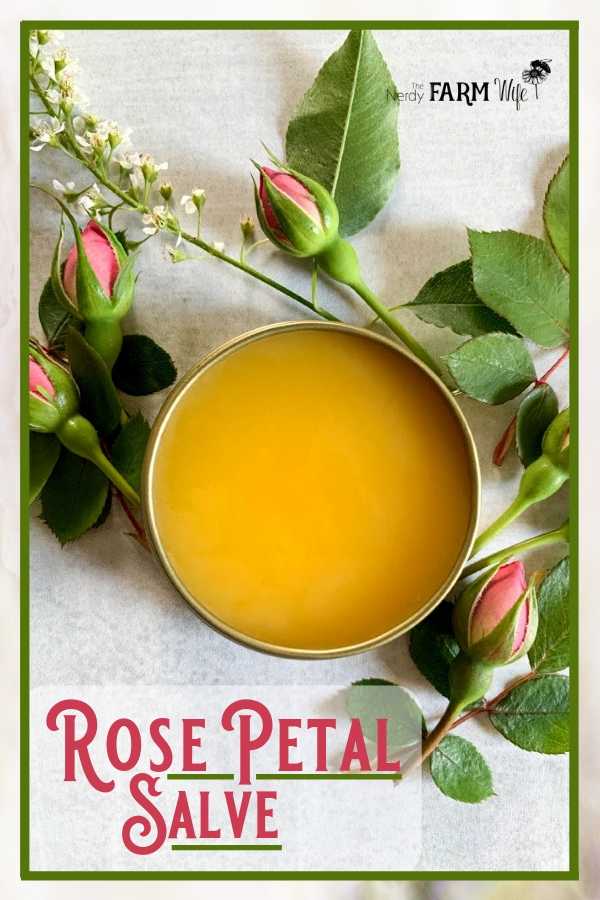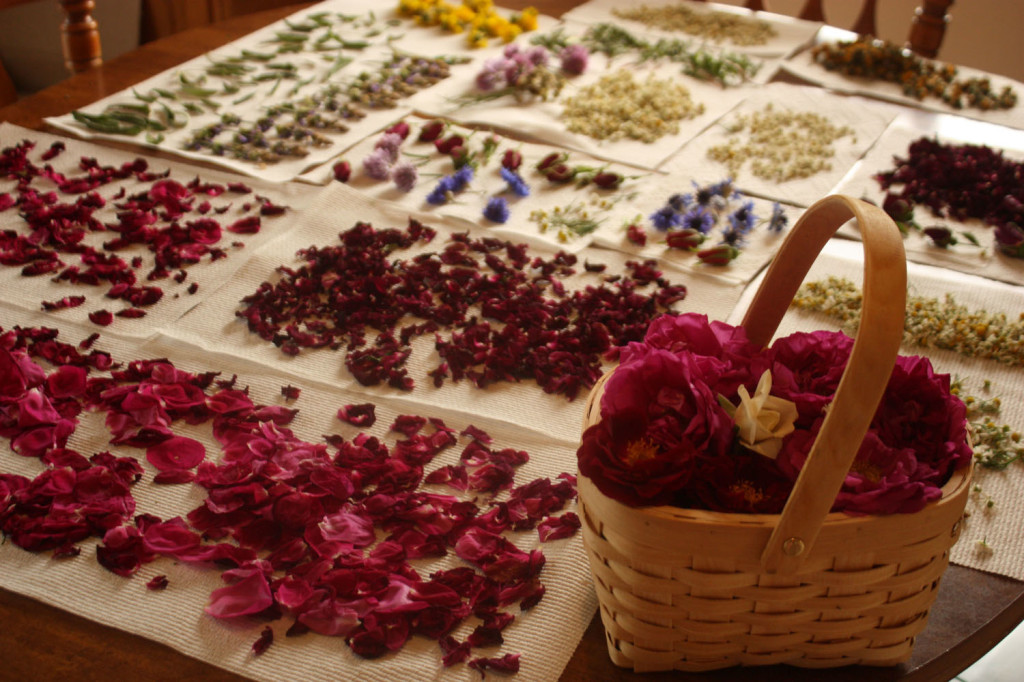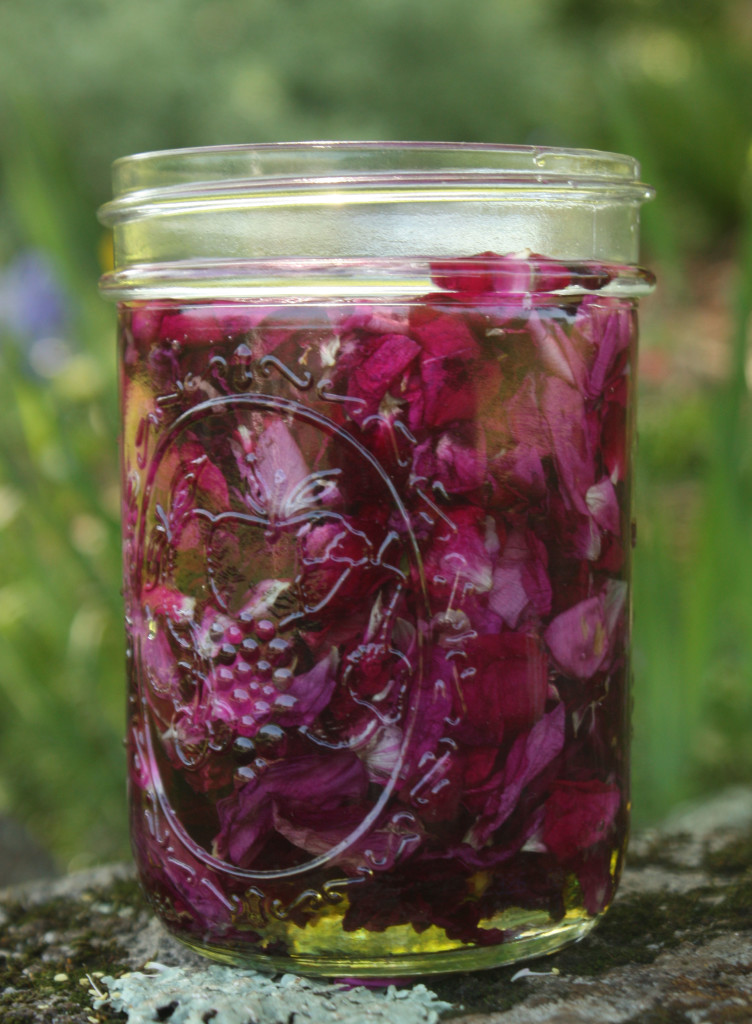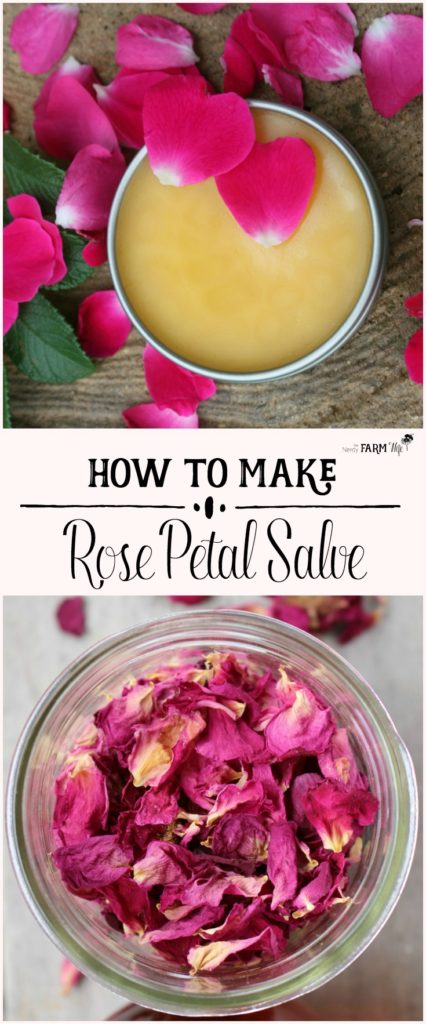Rose Petal Salve Recipe
This rose petal salve recipe is made with real rose petals along with rosehip seed oil, which has amazing benefits when applied to mature, sun-damaged, dry, or irritated skin.

Today’s project is Rose Petal Salve!
I like to enrich this salve with Rosehip Seed Oil which is well known for its anti-aging and skin healing benefits for conditions such as:
- Scars
- Stretch Marks
- Eczema & Psoriasis
- Age Spots
- Wrinkles
- Sun Damage
I dab rose petal salve around my eyes & use on my face. I have dry skin & am old enough to start worrying about wrinkles, so this works perfectly for me.
If you have oily or acne-prone skin, then salves like this one aren’t usually the best for your face. It’s still great for dry patches on your feet, elbows & knees though!
Some links on this site are affiliate links. I earn a small commission for sending customers their way. As an Amazon Associate I earn from qualifying purchases.
My favorite rosehip seed oil comes from Mountain Rose Herbs. If you don’t have any on hand, you can just substitute more of your homemade rose infused oil instead and it will still make a nice, but less effective salve.
Step 1: Dry the Rose Petals
To make this, first you’ll need to gather up some unsprayed rose petals. If you don’t have any fresh roses, you can buy dried, organic petals from places online such as Mountain Rose Herbs.
Don’t use roses from the florist as they’ve usually been treated with pesticides that haven’t been tested for use on human skin.
Once you have a collection of rose petals, spread them out in a single layer over some paper towels or dish towels. Let them wilt for a few days, until completely dry.
Here’s a picture of my kitchen table with flowers drying on it. It’s very low tech with nothing fancy needed, but it works!
Related: How to Harvest and Dry Flowers & Herbs from Your Garden

Step 2: Make an Infused Oil
Once the petals are completely dried, you can turn them into an infused oil.
To make an infused oil: Place the dried rose petals into a jar. The size of the jar will depend on how many flowers you have. For a small amount, use a small jar; if have a good supply, use a bigger jar.
Don’t get hung up on precise numbers and amounts. You’re basically filling some type of container about 1/2 to 3/4 full with dried rose petals then covering them with oil.
Which type of oil is up to you. I like to use Sunflower Oil since it’s good for damaged or dry skin.
Some other good options for this salve are Sweet Almond Oil, Apricot Kernel Oil or Jojoba Oil.
Apricot kernel and jojoba oil will absorb into your skin a bit quicker, while sweet almond and sunflower oils are a little slower to absorb.

There are two ways to infuse your oil. The slow way or the fast way.
For the slow way: cover the top of your jar of oil with a lid (or you could also use a couple layers of cheesecloth secured with a rubber band). Place in a cabinet and let it sit for 3 to 4 weeks.
For the fast way: gently set the jar into a pan with a few inches of warm water and heat slowly over medium lowish heat. Keep the burner on and let the oil stay in the heated water for one to two hours then remove.
At this point, you can go ahead and strain the oil and use in your salve or you can let it infuse several days longer in a dark cabinet. Another option is to strain the oil then do the whole process again with a new batch of rose petals but the same batch of oil you just finished infusing. This is called a double infusion.
The shelf life of your strained oil is about a year. Store in a cool, dark place for best results.
Once the oil is ready, it’s time to make the salve!
Step 3: How to Make Rose Petal Salve
- 3 ounces (100 g) of rose petal infused oil
- 0.5 ounce (14 g) rosehip seed oil
- 0.5 ounce (14 g) of beeswax pastilles
- optional: several drops of rose essential oil (or you can use rose geranium for a less expensive, but still rosy smelling option)
Ingredients are measured by weight.
Add the rose petal infused oil and beeswax pastilles into a heat proof container. (Rosehip seed oil is heat sensitive, so that will be added later.)
Set it down into a pan containing several inches of water (just like when infusing rose petal oil.)
Gently bring the temperature up to medium-lowish heat and let the container stay in the makeshift double boiler until the wax is melted.
Remove from heat and stir in the rosehip seed oil.
Carefully pour into tins or jars then let sit until firm. This size batch yields about four ounces of salve. I buy tins and small jars from Specialty Bottle or Mountain Rose Herbs, but you could even recycle an old jelly jar for this.
*For a vegan salve: Try using half as much candelilla wax instead of the beeswax.



love your ideas!
Thank you Judy! :)
Very good information, thank you. I’ve been making my rose oil using David Austin rose called “Mary” it is an old english type of rose – lots of petals (pink colour) and quite fragrant. I use double infusion and wait until it’s done the long way (I’ve got lots of time and patience). Some batches have a little of essential lavender oil added. I love this oil on my skin after a shower (dry skin). As well I make a salve for my face using the rose oil and beeswax – I need it (73 years old). Keep up with good work, your site is very interesting. Thank you.
That sounds like a marvelous rose Irene! I make my oil the slow way as well, but like to give the option for those who want a quick successful completion. :) Your oil and salve sound lovely – I like the idea of adding lavender essential oil! Thank you for the very nice words, as well. :)
Do you mean you do the long infusion twice? That’s how I’m thinking I’d prefer to do it, but I wasn’t sure it would work.
Hi Jennifer! You sure can do the long infusion twice. You don’t have to though, if you don’t have the rose petals or time.
I am so loving all your rose petal idea’s. I have gathered and am drying and checking into all I can do with them. They smell so wonderful!!! Looking forward to making some natural treasures from the all for my self and my family.
Wonderful to hear! :)
Could an infused oil be made in a similar way with lavender flowers?
Hi Judy, Absolutely! Check out my article 10 Things to Make with Lavender:
https://thenerdyfarmwife.com/10-things-to-make-with-lavender/
Hi Jan:
Today I have started your dry rose petal infusion recipe with grape seed oil to make your rose salve recipe, and also have an infusion of witch hazel going…Thank you so much for sharing your knowledge! I have shared your posts often on Facebook. I have a lot of Heritage pink cane roses that smell divine and have been home-distilling my own rose water for many years now~ The trouble is though, that it only keeps in the fridge for a few days and then will get a “Bloom” in the water…So, to naturally preserve it, I freeze it into ice cubes and thaw as needed. However, I would VERY MUCH like to bottle it and give it away as gifts and wonder if you might be able to lead me to a natural preservative that is compatible with rose water….? In the past, I have tried rosewood essential oil but after days and days of searching the web, thought I may as well just ask you! I’ve been looking into borax powder, citric acid and essential oils on Mountain Rose site and would be so happy to hear your thoughts on this matter. Kind regards from B.C., Canada♥
Hi Carla, I love to hear how you’ve been using your lovely sounding roses! Thank you for sharing on Facebook too! :) I do the same thing with my rose water – freeze it in ice cubes. I was JUST reading the other day though that you could use alcohol or witch hazel to preserve it (grain alcohol, not rubbing alcohol.) I can’t remember where I saw it now, quite likely one of my books here. I’ll look and if I find it again, I’ll pass the ratio on to you! I also read somewhere that someone used vitamin E oil to preserve their rose water, but I just don’t see how that would blend well enough or work to kill potential mold/bacteria and such.
What size tin can should I buy in order to fit the entire salve? ;-)
Hi Sophie!
A good way to determine how much a recipe will make is to add up the total ounces of ingredients called for. In this recipe, there are:
3 ounces rose infused oil + .5 ounce rosehip seed oil + .5 ounce beeswax = 4 ounces total
So, you’d aim for a 4 ounce tin or jar. I’ve found that not all containers are created equally and might not hold as much as they say, so you may have a bit left over or sometimes you may not have quite enough. However, that will give you a pretty good guess of how many containers to prep.
Could I use multiflora rose petals? We have acres of those!
Yes, you sure can!
can one make their own hosehip oil-the same way as the rose petal oil? thanks
Hi Kathy, That’s a great question. You could infuse rosehips in oil, just like petals, but I’m not sure it would have the same action as the cold pressed rosehip seed oil that you buy. I’ll have to dig around my books and see if there’s any more information on it. It’s a promising idea though!
Hi Jan,
Just wondering if using an herbal floral water with rose and geranium could work as a substitute for the essential oil?
Hi Janet! You can use an herbal floral water in a cream, since it has an emulsifier that will help the oils and water bind together. If you just add something water based to a salve though, it will ooze out of your finished product. Once you introduce water into a homemade lotion or cream, you instantly shorten the shelf life as well (compared to a salve which should be good about a year), since that’s where bacteria and mold can grow. I don’t use chemical preservatives (though you can), so I just refrigerate homemade creams and try to use them up within a few weeks. Here’s a recipe for rose cream where you could use your floral water: https://thenerdyfarmwife.com/rose-face-body-cream-recipe/
can you use two different oil when infusing? Like sweet almond & jojoba to infuse rose petal with oil?
Thank you.
Hi Tammie, You sure can!
Hi Tammie, You sure can!
I love this! I have a lot of roses and petals. I’m glad that I saw not to use petals from florists on skin. I didn’t think about the sprays they may use. I will be giving this a try, thanks for sharing!!
Hi Dez, I’m so glad that you like the recipe! It’s one of my all time favorites!
I’m new to the “oil” world. I am following your recipe for rose oil. I’ve got two batches going. One with olive oil and one with almond oil. I’ve got a couple of questions. Is there a special olive oil to use or is it the same kind you might cook with? How long will the oil keep? If I can’t make the rose salve right away can I just use the oil on my skin and when I do make the salve how long will it keep? OK more then a couple. :) Thanks
Hi Nedra! If you buy it from a store with a high turnover rate (for freshness), then you can use the same type of olive oil that you use for cooking. How long it keeps, depends on how fresh the oil is when you buy it, but usually around nine months to a year is a good guideline for infused oils intended for cosmetic purposes. You can use the oil right away on your skin; the salve just makes it easier to apply. When you do make the salve, if you made it with freshly infused oil, it could last 9 months to a year. If you make it with oil that has been sitting around a long time, the shelf life will be shorter. You can tell if an oil or salve is going bad when it starts smelling a little old and rancid. Another idea, if you don’t want to fool with waxes and making a salve, is to infuse coconut oil with rose petals – like I did with dandelions here: (Roses won’t turn your oil pink, but it’s still a nice oil to use!): https://thenerdyfarmwife.com/whipped-dandelion-coconut-oil-moisturizer/
To make this vegan you said to use Candelilla wax in place of beeswax and to use half the amount.. Why not use the full amount?
Hi Jess! Each wax has its own individual characteristics and properties and are very different from each other, so they can’t be used interchangeably. It takes less candelilla wax to thicken oil than beeswax, so you don’t need as much in a recipe.
Hi Jan thank you for sharing all those lovely recipes. I bought your ebook “things to do with roses” some time last year could be around July/August can’t remember but my computer got a virus and was acting up so badly that I put it aside. It was a very old model and was using windows X. The thing is that I have lost the pass word to get the info onto my new android phone. Please could you send it back. Thank you so much.
Hi Rhoda, Sorry to hear about your computer trouble! I found your receipt & just sent a new rose ebook download link to your email address. Sometimes the program acts a little buggy with android phones, so if it does, just let me know and I’ll try a different way. Thanks!
I just posted this page to an FB Group for people with psoriasis and psoriatic arthritis. We battle this on a daily basis and I’m very interested in trying the Rose Salve. Thanks for sharing your knowledge in this way.
Thanks for sharing Kathy Mc! I hope it helps someone!
I was wondering if you could add some vit. e oil to the rose infused oil to prolong its shelf life. If so, how much to a jar?
Hi Joy! You could definitely add vitamin E oil to your rose infused oil. I usually just squeeze the liquid contents of a gel cap into my oils, so don’t really have a specific amount I follow. Keeping infused oil in a cool place, out of direct sunlight will go a long way to preserving it as well.
I made this lovely salve and added Tamanu Oil, so I did .25 oz of Rosehip and .25oz of Tamanu and followed the rest of the recipe exactly. Just wondering if I did something wrong because it never absorbs into the skin, I end up having to wash it off. I have mostly been using it as you say on my face and under my eyes, even tried it on my hands that are very dry but it doesn’t seem to absorb even after being on for hours, is this how it’s supposed to be? This is the first salve I have ever used so maybe I’m just not used to how it works or I did something wrong? Thanks! Love your site and recipes!
Hi Lisa! Salves are very oily and a tiny dab will go a long way. You could take your pinky finger and barely get some on it and it would be enough to dab around both eyes. I apply it at night, so it has plenty of time to absorb in.
You might be applying too much, or they might just be too heavy for your skin type.
You may like something lighter, like a lotion.
Here’s one recipe that I really like that absorbs in quickly:
https://thenerdyfarmwife.com/basil-anti-aging-face-cream/
You could use your rose infused oil, in place of the hemp and skip the basil infusion. (I’ll have more lotion recipes to share too, over the coming months.) :)
I made this wonderful salve this spring after a glorious rose crop. I added Jasmine as a scent in addition to rose hip. I was so excited how this turned out and how easy it was to make. I have given away most of the two batches I made, and have used this salve myself daily since spring. I love this salve and will make more this fall after the roses start blooming again. I was blessed last night by giving someone some salve, and I’d like to thank you for this recipe. I gave some of this to one of my patients at the Emergency Department where I work. This young lady has End Stage Renal Failure which means her kidneys have failed to the point where she must have dialysis three days a week for the rest of her life.Patients with renal failure have very dry, scaly burning skin and it is a constant complaint for them. I had taken some salve to work and decided to give it to her. I had put it in a very pretty container. She was ecstatic! She was so happy, she put it on one leg and when I came in she said for me to look at the difference! She loved the scent, and her and her husband gave me big hugs for this little gift! You never know how you can bless people with little surprises and I thank you again!
Hi Joan, I loved reading this! How wonderful that your rose salve was such a blessing. I bet it smelled so lovely and uplifting with the jasmine added – I love that idea! Thank you for the reminder as to how we can bring happiness to others in so many ways with our handmade projects. :)
Jan,
I was reading through your method of infusing oil using dried roses the “slow” way, and am I understanding correctly that you do not put a lid on the jar? Just cover it with secured cheesecloth. I would worry about dust and moisture getting into the jar after 3-4 weeks even in a dark cabinet. Or possibly getting knocked over. Also, would the temperature of the house affect the infusion process? For instance, my house is usually about 77 to 78 degrees. Thanks!
Hi Nel! I only kept the cheesecloth on if I started with wilted (not completely dry) rose petals, so any extra moisture could evaporate, instead of building up on a lid. These days though, I really prefer working with completely dry plants, to eliminate any worries about mold or bacteria setting in & would definitely cover with a solid top. Thanks for pointing that out to me – it’s a good reminder that I need to go in and update this and some other old posts for consistency! It’s possible that a really cold house might slow an infusion down a bit, but over a period of weeks, I don’t think it will matter. My house stays around 77 to 78 degrees too, with higher peaks sometimes. (No central air and we heat with a wood stove in winter.) Infusing oils the slow way is a very imprecise method and it all works itself out, even with a million little variations thrown in. :)
Would it be ok to dry them in the oven on 200°?
Hi Shay! You could definitely try that, though I’d go as low as your oven permits and keep a close eye on them.
Thats good to know. It did not take as long yo dry them on the counter as i thought it would. I thought i had a lot. Lol the volume shrunk down to a cup and a half.
Yes, they sure do shrink a lot! I’m glad they dried well for you!
Love your post….just found it today…couldn’t stop reading about your differt oils and methods….can’t wait to try your salve recipe… Thank you for sharing your ideas and knowledge